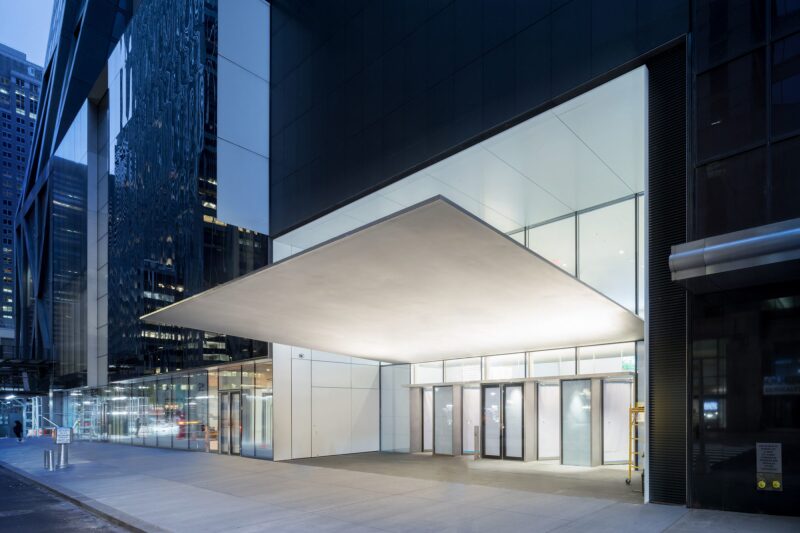After closing for four months to undergo an extensive—and expensive—overhaul, one of New York City’s most-visited museums is officially open to the public as of October 21. Fresh from a $450 million renovation, the Museum of Modern Art (MoMA)—which now stretches along most of the block on Midtown’s 53rd Street, between Fifth and Sixth Avenues—was revamped by design studio Diller Scofidio + Renfro, in collaboration with design and architecture firm Gensler, to include a made-over lobby, a newly expanded bookstore, and more than 40,000 square feet of additional gallery space.
But when you walk through the expansive new space, it’s clear that MoMA’s makeover has more to offer visitors than just extra room to roam. Inside the spacious, six-floor building, which now spans 165,000 square feet of gallery space, thoughtfully curated exhibits reflect an updated vision of what “modern art” means today.

The inaugural presentation in MoMA’s Marie-Josée and Henry Kravis Studio highlights “Rainforest V (variation 1),” a sound installation conceived by composer David Tudor and realized by Composers Inside Electronics, Inc.
Photo by Heidi Bohnenkamp, Courtesy of MoMA
While iconic artworks by the likes of Monet, Van Gogh, Picasso, Warhol, O’Keeffe, and Kahlo remain on view at MoMA, visitors will now see them displayed next to a wide range of works by less familiar artists from more diverse geographies and backgrounds than ever before.
In one fifth floor gallery, for example, Picasso’s 1907 Les Demoiselles d’Avignon—which was at first highly controversial for its style and subject matter (of female brothel workers)—is placed near a 1967 artwork by Harlem-born artist Faith Ringgold. Ringgold’s painting, titled American People Series #20: Die, depicts a scene of interracial violence among men, women, and children. “It’s interesting to see those things together,” says Jodi Hauptmann, senior curator of drawings and prints at MoMA. “Sometimes even small juxtapositions can have a big impact.”
Within certain galleries, viewers can also explore what artists in different parts of the world were creating during the same time period. “On the fifth floor, Van Gogh’s The Starry Night is now shown in the same gallery as a collection of ceramics made at the same time by George Ohr, of Biloxi, Mississippi,” Hauptmann adds. According to the museum’s curators, the overarching goal is to make modernism feel fresh and challenging again. “The real value of this expansion is not just more space, but space that allows us to rethink the experience of art in the museum,” says Glenn D. Lowry, director of MoMA.

On view through through April 20, 2020, the “Artist’s Choice: Amy Sillman—The Shape of Shape” exhibit on MoMA’s fifth floor includes nearly 75 artworks selected by Sillman, many of them rarely seen.
Photo by Heidi Bohnenkamp, Courtesy of MoMA
As part of this “rethinking,” MoMA has also made more of its collection available to visitors, with more than 2,500 works from the museum’s archives now on view—hundreds more than previously presented. (According to MoMA curators, the museum acquired over a fourth of these works in the past five years alone.)
Various galleries are medium specific, while others integrate sculpture, painting, design, architecture, photography, film, and more, in galleries held together by what the museum calls a “general chronological spine.”

MoMA commissioned six long-term, site-specific works as a celebration of the October 21 opening, among them “PEACE is POWER” (2019) by Yoko Ono, designed for the Louise Reinhardt Smith Gallery.
Photo by Heidi Bohnenkam, Courtesy of MoMA
As part of its renovation and expansion, the 90-year-old institution also features a larger ground floor that includes two new public galleries. MoMA also promises to rotate many of the works in its galleries every six months, with continued programming that “reacts to, questions, and challenges histories of modern art and the current cultural moment.”
“The idea is that the museum will now be a more engaging destination for both repeat visitors, as well those visiting the museum for the first time,” says Michelle Elligott, chief of archives, library, and research collections.
The result? A rewarding, modern maze for museumgoers that’s both a home for art and a work of art in itself.
The Museum of Modern Art (MoMA) is open daily from 10:00 a.m. to 5:30 p.m. Tickets cost $25 for adults, $18 for seniors and visitors with disabilities, and $14 for students with full-time identification. Members and children under 16 enter for free.

The Museum of Modern Art’s $450 million expansion and redesign was helmed by Diller Scofidio + Renfro in collaboration with Gensler.
Photo by Iwan Baan, Courtesy of MoMA
The Associated Press contributed reporting to this article.
>> Next: Plan Your Trip With AFAR’s Guide to New York City











